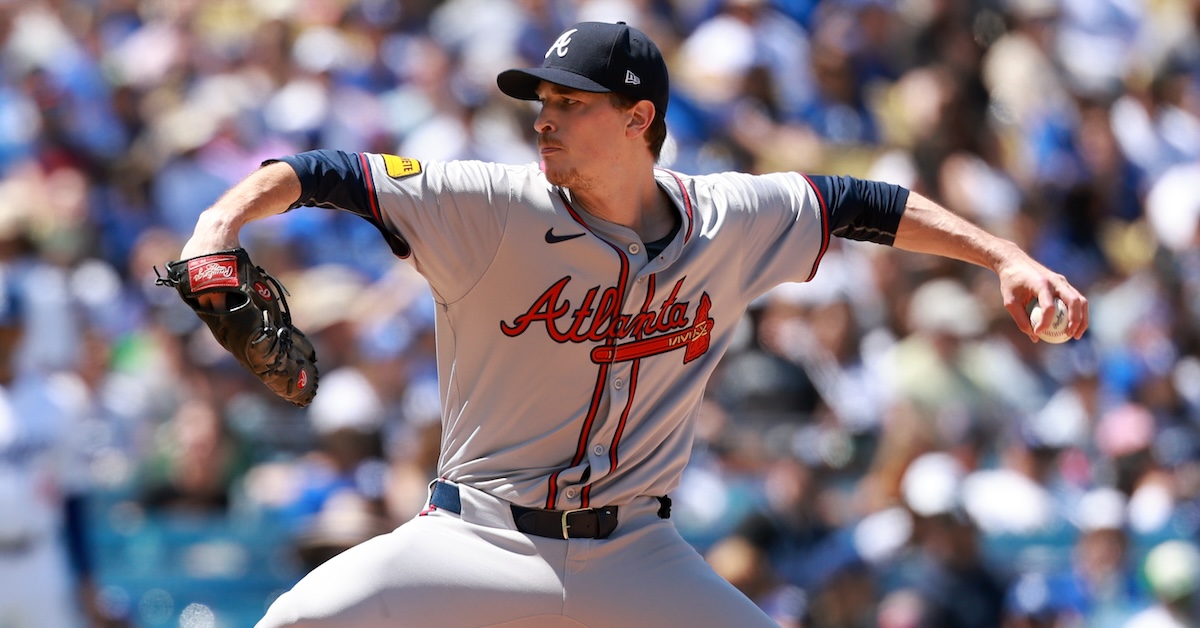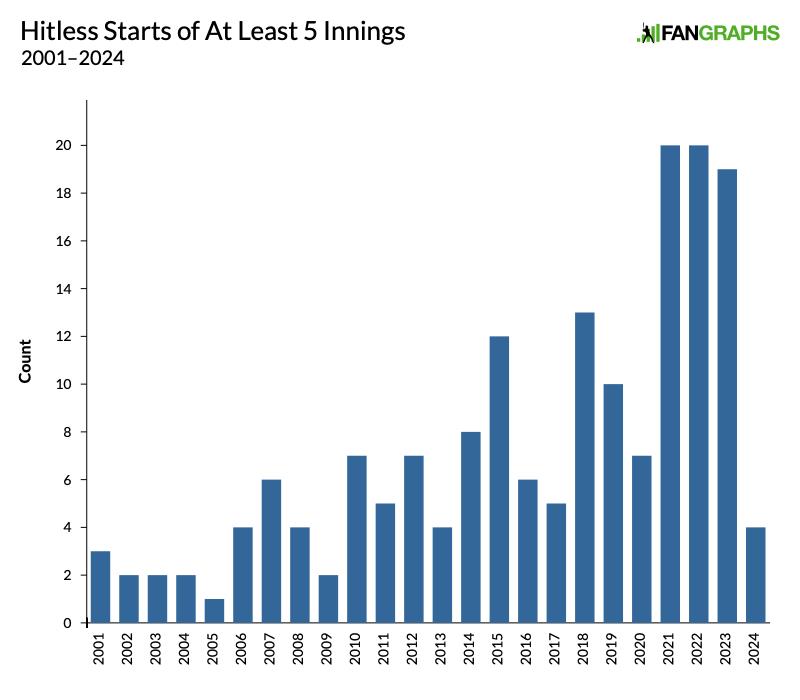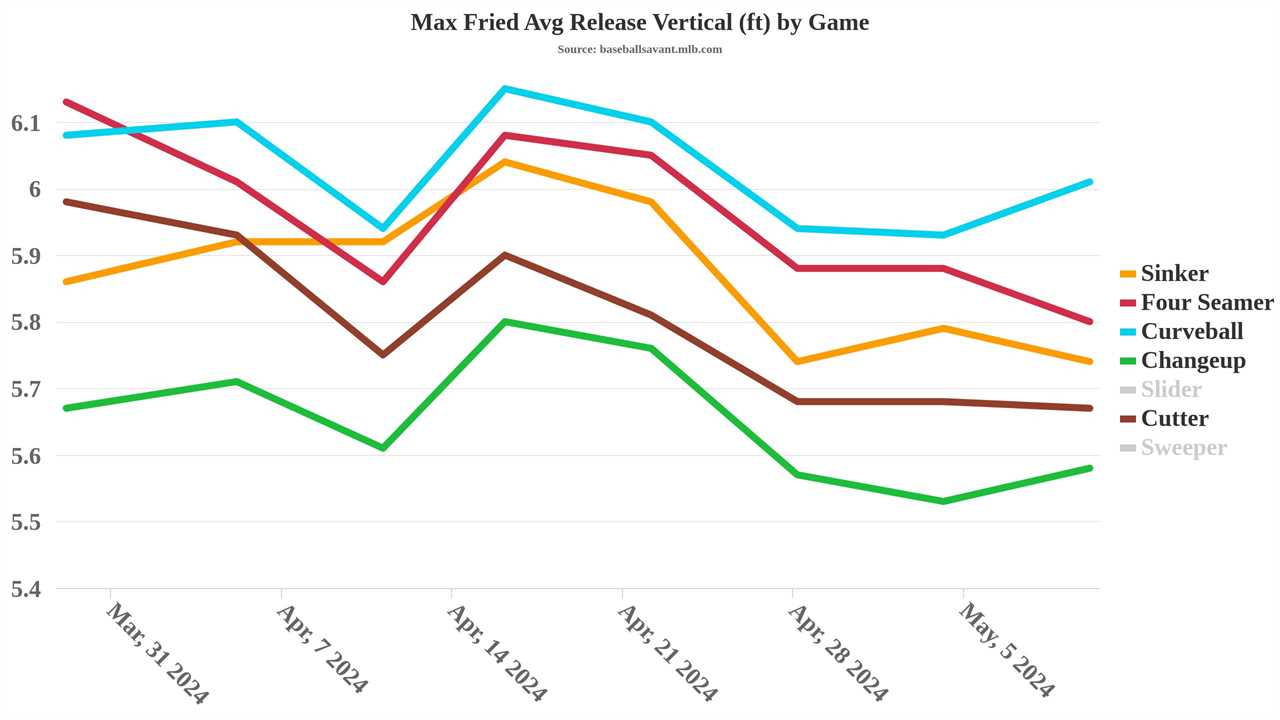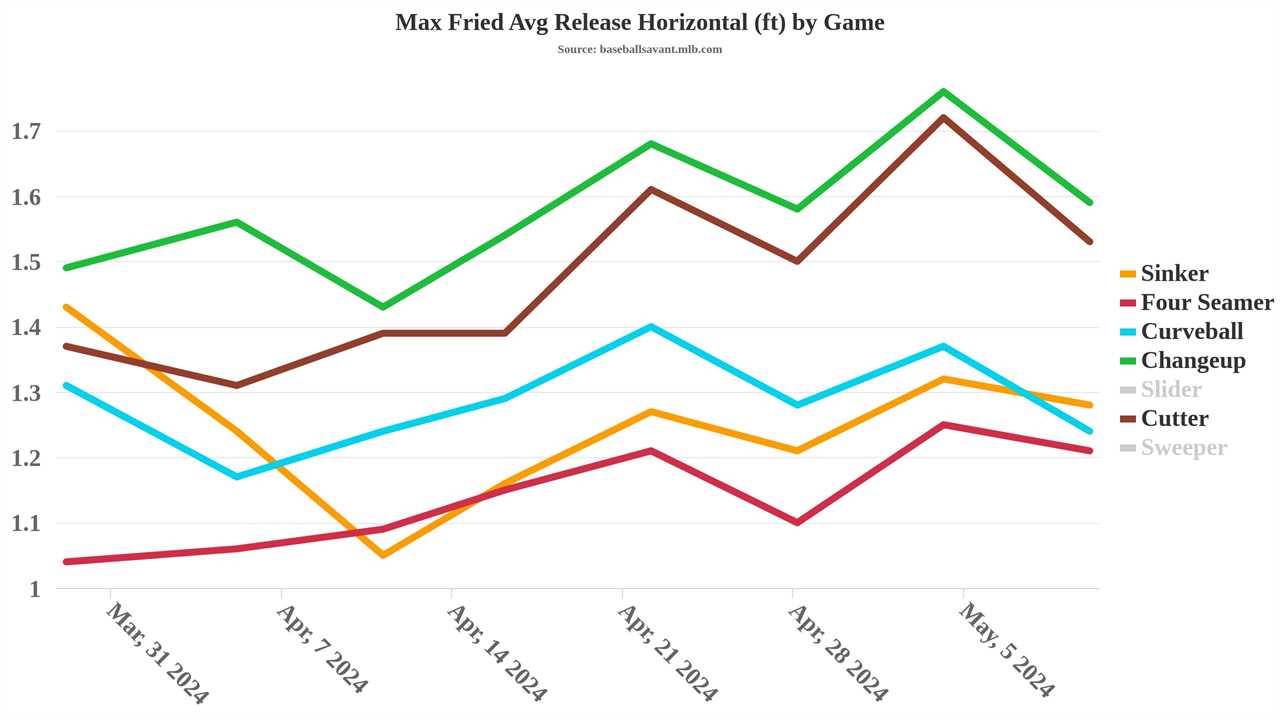
Kiyoshi Mio-USA TODAY Sports
On Saturday at Citi Field, Max Fried was unhittable. For seven innings, the 30-year-old lefty baffled the Mets, surviving a handful of hard-hit balls, including two that would have been home runs in several other ballparks. But because he walked three batters, went to a three-ball count against five others, and needed 24 pitches to complete the seventh while running his count to a season-high 109, Fried got the hook from manager Brian Snitker. He could only watch as J.D. Martinez — who had already hit two scorchers of at least 105 mph off Fried — clubbed a solo homer off closer Raisel Iglesias with two outs in the ninth. The Mets’ rally would ultimately fall short, but the run left the Braves still searching for their first no-hitter since Kent Mercker’s gem on April 8, 1994.
If Fried’s hitless outing evoked a sense of déjà vu, that’s because he did a very similar thing just 12 days earlier. On April 29 in Seattle, he and the Mariners’ Bryce Miller each held the opposing lineup hitless through six innings, the first time two pitchers did that in the same game in just over three full years. Miller faltered first, giving up an infield single to Ronald Acuña Jr., who came around to score; meanwhile, Fried departed after 100 pitches, and while Pierce Johnson pitched a hitless seventh inning, Joe Jiménez surrendered a single in the eighth. Unlike on Saturday, the Braves lost that one on a walk-off homer.
With those two hitless outings, Fried joined some select company. In the post-1960 expansion era, just four other pitchers have made two hitless starts of at least six innings in the same season, five if we consider the postseason:
Multiple Hitless Starts of At Least 6 Innings in the Same Season Since 1961
SOURCE: Baseball-Reference
* = includes one World Series start. ** = combined no-hitters
The list is heavily tilted towards the very recent past, something that becomes even more apparent if we lower the bar to outings of five hitless innings:
Multiple Hitless Starts of At Least 5 Innings in the Same Season Since 1961
| Player |
Team |
Season |
Count |
No-Hitter |
| Justin Verlander |
HOU |
2022 |
3 |
0 |
| Dean Chance |
MIN |
1967 |
2 |
1 |
| Nolan Ryan |
CAL |
1973 |
2 |
2 |
| Nolan Ryan |
TEX |
1990 |
2 |
1 |
| Tim Lincecum |
SFG |
2014 |
2 |
1 |
| Chris Young |
KCR |
2015 |
2 |
0 |
| Max Scherzer |
WSN |
2015 |
2 |
2 |
| Mitch Keller |
PIT |
2020 |
2 |
0 |
| Cristian Javier |
HOU |
2022 |
2* |
2** |
| Framber Valdez |
HOU |
2023 |
2 |
1 |
| Lucas Giolito |
CHW |
2023 |
2 |
0 |
| Max Fried |
ATL |
2024 |
2 |
0 |
SOURCE: Baseball-Reference
* = includes one World Series start. ** = combined no-hitters
In his first season back from Tommy John surgery, the 39-year-old Verlander — who already had three no-hitters under his belt — was pulled after five hitless innings twice and after six hitless innings once. The Astros bullpen failed to finish the job any of those times, but they did so twice in a pair of starts by Javier that same season, the second of which took place in Game 4 of the World Series. None of the other outings above became the first leg of a combined no-hitter, though prior to a 1991 rule change that limited the definitions of no-hitters and perfect games to those of at least nine innings, Chance’s five perfect innings against the Red Sox in a rain-shortened game on August 6, 1967 was considered a perfect game. Ryan’s incomplete effort was on Opening Day, April 9, 1990, a point at which he already had thrown five no-hitters. He tapped out after 91 pitches and five innings, having walked four batters. “I knew I wasn’t going to go nine tonight, so I didn’t give it any thought… If we had a full spring training, it would have been different,” he said afterwards, alluding to a lockout-shortened spring training that had limited the buildup of his pitch count.
Pitchers from the past decade account for nine of the 12 spots, with the other three the only ones from the previous 40 years. Until the era of pitch counts and workload monitoring, a pitcher getting pulled with a no-hitter in progress was extremely rare, but it’s become much more prevalent in recent years — which sure as hell isn’t to say that it’s beloved, so much as merely tolerated. Filtering out the complete game no-hitters and the two hitless seven-inning double-header games from 2021 (one by Madison Bumgarner, the other by five Rays pitchers in a trench coat), here’s a decade-by-decade count of the number of times a pitcher was pulled with a no-hitter in progress during the expansion era:
Pulled After 5+ Hitless Innings
| Years |
5+ Hitless |
| 1961–1970 |
9 |
| 1971–1980 |
8 |
| 1981–1990 |
15 |
| 1991–2000 |
20 |
| 2001–2010 |
14 |
| 2011–2020 |
46 |
| 2021-2024 |
49 |
SOURCE: Baseball-Reference
Includes combined no-hitters and games in which a hit was later recorded, but not seven-inning hitless doubleheader games from 2021 (2).
Less than halfway through the current decade, we’ve already surpassed the total of such starts from the past decade, and we’ve equaled the sum of the previous three decades before that, when getting pulled in the midst of a no-hitter was a once- or twice-a-year phenomenon league-wide. Here’s a look at the progression since the start of the millennium:

The practice has really taken off since 2018, which happens to be the year I joined the FanGraphs staff; it was around this time that season that I took my first look at the topic. At a time when the annual major league batting average has slipped into the .240s — it’s actually dipped to .239 this week — it’s become so acceptable to pull a starter with a no-hitter in progress that six of the past 12 no-nos (including the World Series one) have been combined efforts. The practice has been amplified by teams’ understanding of the times-through-the-order penalty, as well as workload concerns related to the shortened 2020 season, which amplified teams’ caution regarding year-over-year workload buildups, and the ’22 lockout, which limited pitch count buildups that season. Brainstorms on how to restore the primacy of the starting pitcher have become an annual rite.
Fried has never particularly been a workhorse, topping 180 innings just once (2022) and making 30 starts just twice; Saturday’s 109-pitch effort was just one shy of his career high. The Braves can certainly be excused for exercising caution with him following a season in which he was limited to 14 starts and 77.2 innings due to a forearm strain that cost him three months and then a blister that limited him to 10 innings (four in the postseason) after September 12. Though he finished with a 2.55 ERA and a 3.14 FIP, his 1.9 WAR was his lowest in a full season since 2019.
Despite those two hitless outings, through eight starts totaling 45 innings Fried is currently sporting a 3.57 ERA and 3.90 FIP, marks that would be his highest since 2019 and that owe plenty to his struggles in his first two turns. In his season debut on March 30, he retired just two of seven Phillies he faced while throwing 43 pitches, walking three and allowing three runs before getting pulled. In his second start, against the Diamondbacks on April 6, he yielded six first-inning runs including a leadoff homer by Ketel Marte (who added an RBI double in the same inning) but hung around until the fifth, when he got into a jam and was charged with two more runs.
Through those two starts, Fried owned an 18.00 ERA and a 5.73 FIP, but since then, he’s posted a 1.79 ERA and 3.68 FIP over six starts totaling 40.1 innings, with batters hitting just .134/.222/.209 against him; over that span, no pitcher has allowed a lower batting average, slugging percentage, or wOBA (.205). Two of those starts were against the lowly Marlins, first a 6.1-inning, one-run effort in Miami on April 12 and then a sterling three-hit shutout in Atlanta on April 23. In the latter outing, he didn’t walk a batter, faced just 29 hitters, and threw just 92 pitches — behold, a Maddux, the third of his major league career. In the span since his 2017 rookie season, no other pitcher has thrown more than one.
So what’s changed for Fried lately? One answer seems to be his release point:


As you can glean from the graphs at Baseball Savant, in his earliest starts, Fried was coming more over the top, with a higher vertical release point — an average of 6.13 feet for the fastball in his first start and 6.01 feet in his second, points in line with his previous track record — but he’s lowered that to averages of 5.88 feet or lower in his last three starts; meanwhile, his horizontal release point has increased from 1.04 feet in his first start and 1.06 in his second to above 1.2 for his last two turns. Within those starts there’s some variation, and likewise with respect to his other offerings (Statcast considers him to have a seven-pitch arsenal, albeit with his slider, sweeper, and cutter used only 5–7% of the time). If we bucket his four-seam results by release height, we do see a marked contrast:
Max Fried Four-Seam Fastball Results by Release Height
| Vert Release |
% |
PA |
AVG |
xBA |
SLG |
xSLG |
wOBA |
xwOBA |
Whiff% |
Barrel% |
HH% |
| 5.95 or Higher |
47.1% |
33 |
.357 |
.288 |
.500 |
.393 |
.424 |
.355 |
12.7% |
8.7% |
34.8% |
| 5.94 or Lower |
52.9% |
34 |
.107 |
.194 |
.214 |
.384 |
.237 |
.323 |
29.5% |
9.5% |
23.8% |
SOURCE: Baseball Savant
The expected numbers aren’t that far apart, but as far as the actual numbers, they’re night and day. The fastballs released at 5.94 feet or lower, which tend to produce more rise and more horizontal movement than the ones with higher release point, have been much more effective, collectively holding batters to a piddling batting average and slugging percentage while producing a whiff rate more than twice as high.
Zooming out, it’s worth noting that Fried’s results by pitch type this season are generally very good; batters are slugging .357 against the four-seamer and .222 or lower against all of his other offerings besides the curve (.407). However, he’s missing fewer bats than usual. His whiff rates on his two main secondaries, his curve and changeup, are both down substantially relative to last season (from 39.1% to 32.7% for the former, and from 37.7% to 25% for the latter). His overall swinging strike rate has dropped from 11.7% to 9.3%, and his strikeout rate from 25.7% to 20.4%, his lowest since his rookie season. With his walk rate rising from 5.8% to 9.4%, his strikeout-to-walk differential has plummeted from 19.9% to 11%. All of that is at least a bit alarming.
Fried has offset that trend by using his sinker more often than ever, throwing it 16.9% of the time, up from 11.7% last year, and a previous high of 13.3% in 2022. His results on the pitch have improved, from a .267 batting average and .324 slugging percentage in 45 plate appearances to a .138 AVG/.138 SLG in 33 PA. His groundball rate on those sinkers is almost 70%, and his overall 62.9% groundball rate leads the majors. Fried has been good at limiting hard contact, to the point of posting his lowest average exit velocity and hard-hit rate of the past four seasons, but thanks to the erosion of his strikeout and walk rates, his 3.44 xERA is near the higher end of that run:
Max Fried Statcast Profile
| Season |
BBE |
EV |
Barrel% |
HardHit% |
xwOBAcon |
xERA |
| 2021 |
461 |
86.5 |
6.3% |
34.3% |
.345 |
3.47 |
| 2022 |
527 |
86.2 |
4.0% |
31.9% |
.322 |
2.85 |
| 2023 |
211 |
86.5 |
3.8% |
32.7% |
.314 |
2.73 |
| 2024 |
125 |
84.5 |
6.4% |
29.6% |
.325 |
3.44 |
All of which is to say that as these trends come together, we may be seeing the evolution of a new Max Fried. Set aside the ERA and FIP inflated by those early poundings, and it does seem to be working; of the 100 pitchers with at least 40 innings, his overall .185 batting average allowed is the seventh lowest, his .272 slugging percentage allowed the ninth lowest, and his .252 wOBA the 13th lowest. Whatever he’s doing, lately it’s working like a charm.
Source
https://blogs.fangraphs.com/max-fried-has-been-unhittable-lately/
 Backyard GrillingWeekend WarriorsAdvice from DadBeard GroomingTV Shows for Guys4x4 Off-Road CarsMens FashionSports NewsAncient Archeology World NewsPrivacy PolicyTerms And Conditions
Backyard GrillingWeekend WarriorsAdvice from DadBeard GroomingTV Shows for Guys4x4 Off-Road CarsMens FashionSports NewsAncient Archeology World NewsPrivacy PolicyTerms And Conditions
